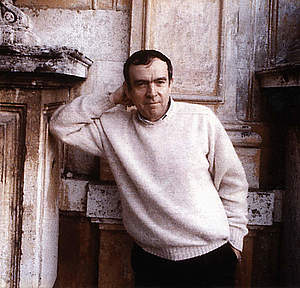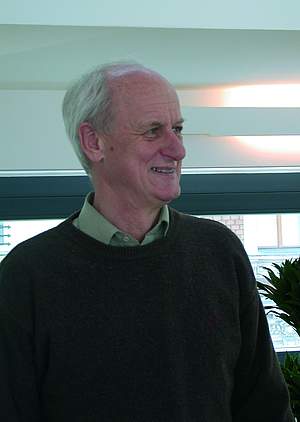European (Union) Affairs Committee
Works actively to present the EFNS at all levels within the EU in Brussels and Strasbourg, follows administrative and legislative initiatives of the EU at the earliest possible states of their development in order to allow for EFNS influence, monitors the possibilities for EU grants to EFNS educational and scientific programmes, provides information about the EU to the EFNS Newsletter and the European Journal of Neurology, takes care of any EFNS matter relating to the EU which is not the specified duty of another committee or the president.
In 2003 the European Union Affairs Committee and the Liaison Committee were merged to the Liaison and European Affairs Committee.
Chairpersons

European Journal of Neurology 1998; 5:117-118
Professor Luigi Amaducci
1932-1998
We have learnt with great sadness of the death of Luigi Amaducci, Associate Editor of the European Journal of Neurology and one of its most committed supporters.
We are certain that all EFNS members will want to join us in expressing to Luigis's family and to his closest colleagues in Florence our sorrow and our sympathy. He will remain with us forever.
Fransois Boller and Per Soelberg Sorensen
European Journal of Neurology
Co-Editors-in-Chief
Professor Luigi Amaducci died in Florence on Sunday, January 11, 1998. He is survived by his wife Maria Pia, a son (Giovanni), and two daughters (Guilia and Bianca). Professor Amaducci obtained his MD at the University of Padova in 1957. He spent three years (1960-1962) in Folch-Pi's Laboratory at Harvard Medical School contributing to studies that pioneered the definition of the biochemistry of the myelin sheath. He then joined the Faculty and the University of Florence where he remained for the rest of his most successful career, being appointed Chariman of the Department of Neurological and Psychiatric Sciences between 1979 and 1983, and 1991 and 1994. In 1989, he was appointed President of the Targeted Project on Ageing of the Italian National Research Council. This project comprises the major effort of Italian research into ageing within a comprehensive framework including biological, pathological, social and economic aspects and the impact of all these upon later life. From a national research project he made this an internationally recognised study by collaborating with European Union (EU) projects. He served as President of the Italian Neurology Society from 1996 and as National Delegate for the Biomedical and Health Research Programme of the EU from 1991 until his death. Another of his many commitments was chairing the Research Group on Dementia of the World Federation of Neurology.
Professor Amaducci was Chariman of the European Affairs Committee of the European Federation of Neurological Societies (EFNS) form the very beginning. He established contacts with the EU and persistently pursued the goal of gaining priority for neurological projects within the framework programmes of the EU. He continuously organised very successful workshops in Brussels and encouraged his colleagues, whenever possible, to join in EU-related activities. His passionate devotion to neurology and his interest in the European neurological community were of outstanding support in the successful development of the EFNS. Not only his innate standard and accomplishments, but his skill and tact in working with committee members and colleagues resulted in continuing commitments. In 1994, when the European Journal of Neurology, the official journal of the EFNS, was launched, he was appointed an Associate Editor. Two years later, in 1996, in addition to his office as chairman of the EFNS European Affairs Committee, Luigi Amaducci became Vice President of the EFNS. In memory of the untiring and versatile colleague, the EFNS will hold a teaching course entitled Luigi Amaducci Teaching Course on Dementia and Alzheimer's disease at the 3rd Congress of the European Federation of Neurological Societies, September 19-25, 1998, in Seville, Spain.
Not only was he a man of science, but he also was a quietly devoted family man who had great respect for his fellow human beings. We all greatly mourn the loss of this unassuming and gentle colleague and friend.
Jes Olesen, European Federation of Neurological Societies (Chair) and Cesare Fieschi, Societa, Italiana di Neurologia (Past President)

Dear friends at the EFNS,
Congratulations to all in particular my old friends Eberhard Deisenhammer, Jacques de Reuck and especially Jes Olesen who was so insrtumental in making the EFNS what it is to day;
Since Jes took over the chair, I left the AAN, where I had been in important committees since 1992, including the Membership Committee (first ever for a non-US member since its origin in 1948...), to join the EFNS when Jes asked me. To my regret I had to resign after some years, not by lack of interest (I still believe that it is the best Neurology Society in the world) but because of accumulating responsibilities elsewhere: Advisor to the WHO (1984), Stroke Council of the AHA (1985), President of the Institut du Cerveau (private fundation), Bordeaux (1990), Scientific Committee of the European Stroke Conference (1991), Chief of Neurology at the University of Bordeaux (1993) Founder and Chairman of the European Stroke Council (1994), EFNS Committees (1996), Expert for Neurosciences to the WHO (1996), Member of the EMEA/CHMP (1997), Chairman of the International Working Group on Dementia Trials (2002), Minister of Research at the Regional Government of Aquitaine (2004), Chairman of the Department of Cinical Neurosciences, CHU of Bordeaux (2007, 2001), Director of the Federation of Neurosciences, University of Bordeaux (2011). I still have other projects but I do support the EFNS in my heart and I am sincerely sorry for my not being able to contribute actively to it success.

It was important for the EFNS to develop friendly relations and good cooperation with a number of other organizations. To this end we created the Liaison committee. We distinguished between four different kinds of organizations with which to liaise: Subspecialty organizations within neurology such as European movement disorder society, related professional organizations such as Neuropathology, Neuroradiology etc., international organizations such as World Federation of Neurology, American Academy of Neurology etc. and finally organizations of allied health professionals such as specialist nurses, physiotherapists, speech therapists etc. Evelyn Sipido who had joined the EFNS staff took responsibility for the administration of this committee. She and several chairpersons worked hard during my presidency to create databases of organizations with which to collaborate and to establish formal relations with those organizations. We created rules for so-called associated organization but found out that other organizations were afraid of being dependent upon the EFNS. We therefore coined the name collaborating organizations. It proved difficult, however, to get going with any significant amount of collaboration. We suggested that these organizations should take out individual membership of the EFNS and thereby get all materials from the EFNS and use this to inform their members. The EFNS would do the same and this could guarantee a relatively high level of mutual information but it never really worked out. The most important result of these efforts was a formal collaboration between the European movement disorder society and the EFNS about having joint meetings at the EFNS congress every other year. This model has later been followed up. When I stepped down as president of the EFNS in 2001, I took on the chairmanship of the committee and found out myself how difficult it was to get any meaningful cooperation and to keep it going. At that time, I was heavily involved in the creation of the European Brain Council and it was decided that these activities would be the most important activities of the committee. Consequently it was renamed the Liaison and European affairs committee.
However, as far as my involvement with EFNS is concerned, the turning point was definitely the EFNS Paris 2004 Congress. My term within the MC expired after four interesting years, and the entrance of Giorgio Cruccu in the MC as Secretary practically blocked the presence of a second italian. Thus I went to Paris taking three of my daughters and my wife and together we definitely attended more museums and shows than I attended scientific sessions. Therefore, on the evening when we were preparing for a nice dinner at Place Pigalle, lobster and fruits-de-mer, and I received a call from the President, Dieter Heiss, asking to see me for a brief private talk, I quickly tied my tie, and hurried downstairs, totally uncertain about the theme of Dieter’s request, let me say slightly worried, because of his serious voice when he called.
My family dinner was a very happy and expensive one as we celebrated the President’s offer of the position as Chairman of the CPC for the years 2006-07 with one of the best french champagnes! And, since I readily accepted, here I am.